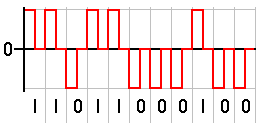Return-to-zero
This means that a separate clock does not need to be sent alongside the signal, but suffers from using twice the bandwidth to achieve the same data-rate as compared to non-return-to-zero format.
The "zero" between each bit is a neutral or rest condition, such as a zero amplitude in pulse-amplitude modulation (PAM), zero phase shift in phase-shift keying (PSK), or mid-frequency in frequency-shift keying (FSK).
Although return-to-zero (RZ) contains a provision for synchronization, it still has a DC component resulting in “baseline wander” during long strings of 0 or 1 bits, just like the line code non-return-to-zero.
It is used (with a pulse 3/16 of a bit long) by the IrDA serial infrared (SIR) physical layer specification.
Required bandwidth for this kind of modulation is: BW = R(data rate).
